iMac 21.5-inch 4K (2017) Review
iMac 21.5-inch 4K (2017) Review
The all-in-one to beat gets even better
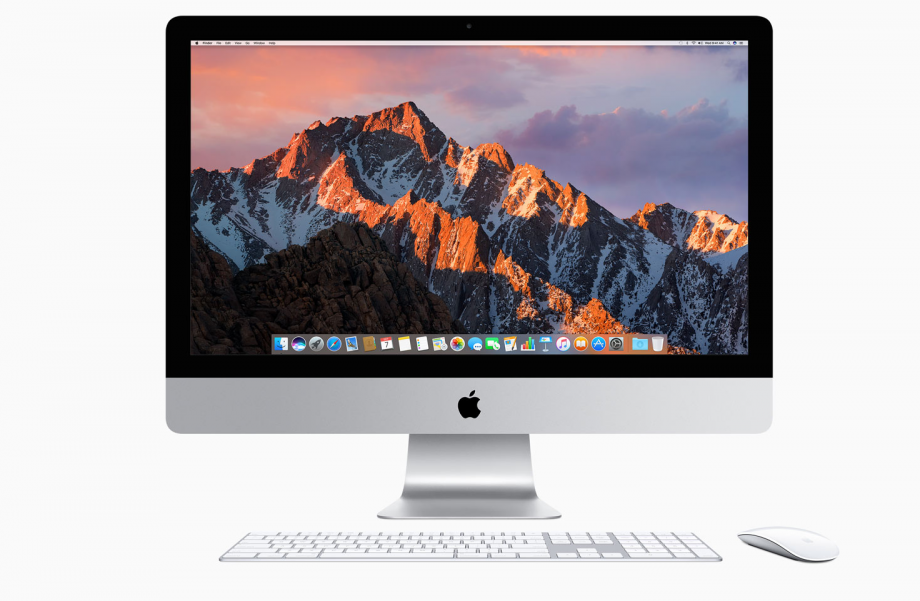
Verdict
Pros
- Stunning screen
- Powerful processor
- Near-silent running
- Good graphics performance
- Excellent peripherals
Cons
- Needs an SSD
- Measly 8GB of RAM
Key Specifications
- Review Price: £1449.00
- 21.5-inch 4096 x 2304 P3 display
- 3.4-3.8GHz Intel Core i5-7500 (upgradable to Core i7)
- 8GB DDR4 memory (upgradable to 32GB)
- 1TB Fusion drive (upgradable to SSD)
- 4GB AMD Radeon Pro 560 GPU
- Magic Keyboard and Magic Mouse 2 included
- VESA-mountable option available
- 4 x USB 3.0, 2 x ThunderBolt 3/USB-C 3.1, Gigabit Ethernet, SDXC card reader, 3.5mm headset jack
- MacOS Sierra
What is the 21.5-inch iMac (2017)?
The 4K 21.5-inch 2017 iMac is a refresh of Apple’s iconic all-in-one. It comes stacked with the latest processor and graphics options, alongside the same butter-smooth Apple experience you’ve come to expect.
If you’re after a powerful and good-looking all-in-one, you really don’t need to look much further.
21.5-inch iMac (2017) – Design and build
If you’ve seen an iMac in the past decade, then you’ll have a pretty good idea of what this latest model will offer. Despite its age, the iMac still offers up great-looking design with its combination of silver aluminium, tapered edges and simple, single-footed stand.
The iMac is a thoroughly modern device when it comes to connectivity. There are four USB 3 ports, a further two high-speed Thunderbolt 3 ports that can handle data at up to 40Gbps – perfect for high-end storage peripherals and monitors – and an SDXC card slot, Gigabit Ethernet and headphone jack.
Related: Best desktops and all-in-one PCs
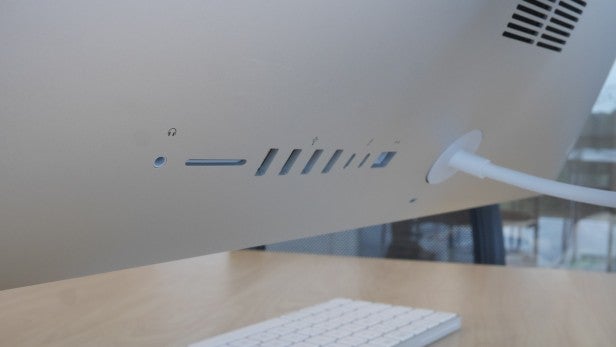
All great, all welcome – but mostly in the wrong place. Even before Apple’s decision to taper the edges of the iMac to almost nothing, the company always chose to place ports on the rear of the system, out of sight. While I make no great objection to most of the ports being placed back there, a single USB port alongside a 3.5mm jack on the right or left-hand edge of the all-in-one would have been most welcome.
For easier access to your hot-swapping peripherals you’ll need to buy a dock. It’s at least easy to swing the iMac around on its foot to gain access to the rear – but it isn’t exactly seamless.
Also, be sure to budget in a bit more if you want to hook up a non-Thunderbolt monitor to your iMac; you’ll need an adapter for VGA, DVI, and HDMI, or a Thunderbolt 3-to-DisplayPort cable for more modern screens.
21.5-inch iMac (2017) – Keyboard and mouse
Apple ships its 21.5-inch iMac with the Magic Keyboard and Magic Mouse 2 (both wireless) as standard, and both peripherals are excellent. The Magic Keyboard is similar to every other Mac keyboard you may have cast your eyes upon. It sports an aluminium body with white keys and grey lettering, and a top row of function keys that modify screen brightness, control media playback and volume, while also helping you to navigate the desktop with Mission Control and the app menu. There’s also an eject button for the non-existent DVD drive.
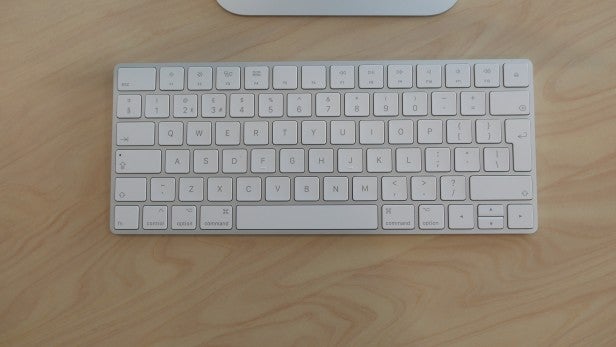
Key travel is short, but short travel is fine if the keypress action is responsive – and in my opinion it’s just about enough. Your fingers can dance across the keyboard with relative ease, and there’s no mushiness whatsoever. I’d have personally preferred a desktop version of the Butterfly keys that Apple uses in its latest MacBooks, but these do the job without issue. The standard keyboard that comes in the box doesn’t have a numberpad, and you’ll pay a cool £30 for the privilege of upgrading to one. But this also nets you larger arrow keys and Page Up and Page Down keys.
The Magic Mouse 2 is excellent, and essential if you want to get the most out of macOS’s gesture-centric design. Upon setting up your iMac, you’ll want to increase the mouse’s movement sensitivity, because it’s hilariously sluggish by default. From there, it moves smoothly across a standard desk and I didn’t experience any range or cut-out problems. The top surface has both a physical click and a touch-sensitive layer, which means you can perform regular clicks and use one- and two-fingered gestures to navigate the OS.
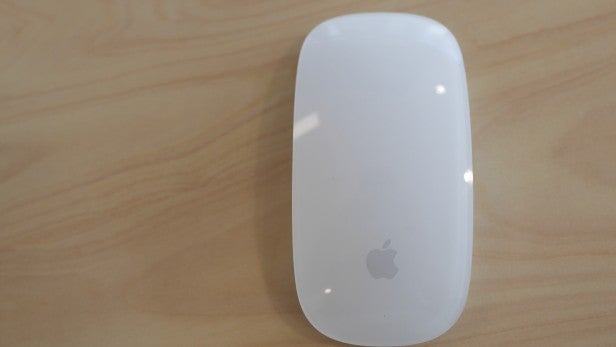
Essential gestures include single-finger scrolling, two-fingered desktop switching and a two-fingered tap for setting up Mission Control just how you like it. Some curious gestures are disabled by default, including single-finger page navigation (going back a web page), and alternative clicks are also disabled by default.
You don’t get the full complement of gestures that you’d find on a trackpad; you can replace the Magic Mouse 2 with the Magic Touchpad instead for £50 extra.
21.5-inch iMac (2017) – Screen
The 21.5-inch iMac’s 4096 x 2304 screen is one of its big talking points – and the panel supplied here by LG is a fine example. My calibration equipment measured 100% of the sRGB colour gamut, 86% of the Adobe gamut and 98.6% of the DCI-P3 gamut. Images shot in RAW will benefit massively, with details that would otherwise be invisible on an inferior screen positively leaping out on the iMac panel.
Related: Colour gamuts explained
It tops out at a significant 532 nits of brightness. This is probably too bright for most people, but manages relatively – if not class-leading – deep blacks measuring in at 0.47 nits. This equates to an overall contrast figure of 1115:1.
Perhaps the only complaint one can have about this screen is its size. 21.5 inches is manageable, but in a world where 24-inch business monitors are the norm, it can feel slightly cramped. This problem isn’t quite so bad thanks to macOS’s excellent Mission Control system, which makes it easy to swipe between desktops, but those who are used to bigger desktops will definitely feel the pinch.
21.5-inch iMac (2017) – Audio and webcam
Audio-wise, the iMac is a powerhouse. The stereo speakers sit behind the screen and manage some super-impressive performances with both music and cinematic content, and are probably the best speakers you’ll find on any desktop PC.
The webcam and microphone, meanwhile, are decent as well. The webcam produces natural images, while the microphone is clear enough for both Siri and folk to understand easily.
21.5-inch iMac – Performance
The 21.5-inch iMac is available with two different processor choices. The Full HD model gets dual-core Intel Kaby Lake processors that are more typically found in laptops, while the 4K model ships with full-fat, quad-core desktop chips, also from the Kaby Lake generation.
You’re looking at a small processor performance bump over the last-gen model, but gains of 20% or more on the generations before that. You can see a full list of the three core iMac options in the table below. Each version comes with a variety of upgrade options thet let you further customise the all-in-one’s hardware.
| Dual-core | Mid-range quad-core | Top-spec quad-core | ||
|---|---|---|---|---|
| Processor | 2.3-3.6GHz Core i5 | 3-3.5GHz Core i5, 3.6-4.2GHz Core i7 (£270) | 3.4-3.8GHz Core i5, 3.6-4.2GHz Core i7 (£180) | |
| GPU | Intel Iris Plus 640 | 2GB Radeon Pro 555 | 4GB Radeon Pro 560 | |
| Memory | 8-16 2133MHz DDR4 (£180 upgrade) | 8-16GB 2400MHz DDR4 (£180 upgrade) | 8-32GB 2400MHz DDR4 (£180 to £540 upgrade) | |
| Storage | 1TB HDD, 1TB Fusion (£90) or 256GB SSD (£180) | 1TB HDD, 1TB Fusion (£90), 256GB SSD (£180), 512GB SSD (£360) | 1TB Fusion, 256GB SSD (£90), 512GB SSD (£270), 1TB SSD (£630) | |
| Screen | Full HD sRGB | 4K ‘P3’ | 4K ‘P3’ | |
| Starting price | £1049 | £1249 | £1449 |
I reviewed the 3.4GHz Intel Core i5-7500. This can be upgraded to Core i7, topping out at 4.2GHz, but I think there are some more pertinent upgrades you should consider before slapping in a better processor.
Related: Intel Core processors explained
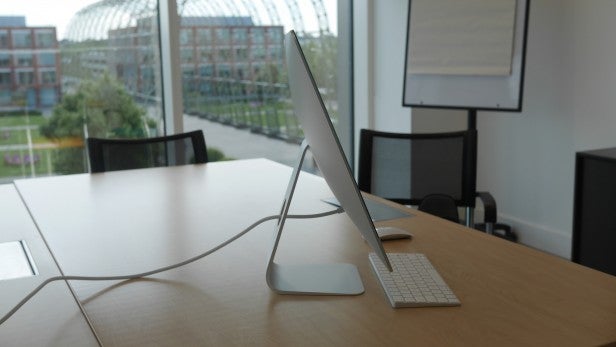
For me, the biggest shortfall here is the storage, which takes the form of a 1TB ‘Fusion’ drive, more conventionally known as a hybrid hard disk or SSHD. This is a combination of a tiny, fast SSD cache and a large, very slow hard disk, with the disk itself intelligently handing frequently used data – such as the operating system and programs – to the SSD to serve up quicker.
In theory, the iMac should become faster the more you use it. But if you’re constantly using new data – such as video files and games – then first there isn’t enough space to speed all that stuff up, and second, you’re not using that data for long enough for it to be worth putting into the cache.
For this reason, large files stored locally feel slow, and programs don’t feel particularly snappy either, with only a limited amount of space to cache them. This will be even worse on the standard hard disk model that starts at £1249, since it doesn’t benefit from any cache whatsoever.
For this reason, I’d recommend specifying an SSD when you buy your iMac, but this will cost you £90 for a 256GB model and £270 for 512GB. That’s a significant outlay, but given how fast the SSD-powered quad-core 15-inch MacBook Pro laptops feel, an iMac with SSD should absolutely fly – and this is the one decision that will absolutely extend its useful lifespan.
The second upgrade is one I’d recommend for video editors in particular: more RAM. As standard, you get only 8GB of DDR4 memory. This will prove ample for most tasks, but high-resolution video projects will really benefit from 16GB – which will once again set you back a cool £180.
If you opt for the mid-range model at £1249, you’ll get a 2GB AMD Radeon Pro 555 GPU, which will be competent enough for basic 3D workloads and some light gaming. The top-spec model here ships with a 4GB Radeon Pro 560. Not only do you get bags of VRAM for larger 3D projects, it’s also fast enough to play a few games. Not at the screen’s native resolution, mind, but I had a fine old time playing Feral Interactive’s macOS port of F1 2016 at 1600 x 900 at Medium settings and anti-aliasing turned on at a very playable frame rate.

I also fired up Civilization VI, and at Medium settings it was very playable. This game is known for being a processor killer; the built-in benchmark showed the iMac handling an AI turn every 23 seconds on average, which is exactly what you’d expect of a quad-core desktop.
Keep in mind that this won’t be the case with the dual-core, Full HD iMac, which only uses its processor’s onboard graphics and doesn’t have any dedicated video memory.
TrustedReviews’ only multi-platform benchmark, Geekbench 4, saw the iMac put in single- and multi-core score of 4789 and 14,054, which iswhere you’d expect it to be. I also tested its mettle in Adobe Premier CC, scrubbing through 4K and Full HD video with captions, without any significant performance problems. Rendering a video, the processor topped out at 3.6GHz – which is just slightly below the maximum Turbo Boost speed of 3.8GHz.
What blows me away about the iMac is how it manages this level of performance while remaining almost completely silent. With a patented fan design and some large heatsinks, even under the most extreme usage scenarios – including editing video, playing 3D games and even both at the same time – the iMac is effectively silent. If you put your ear up to it while it’s under load you’ll hear a faint whooshing, but for all intents and purposes, it’s the quietest fan-cooled all-in-one you can buy today.
Curiously, it is possible to upgrade the processor, memory and storage on the 2017 iMac. Courtesy of iFixit, if you really fancy putting your new purchase at risk to save several hundred pounds – which is tempting – you can actually equip your iMac with 32GB of DDR4 for less than Apple is charging. If you’re feeling particularly daring, you could even swap out the CPU for another compatible model – but I wouldn’t recommend it.
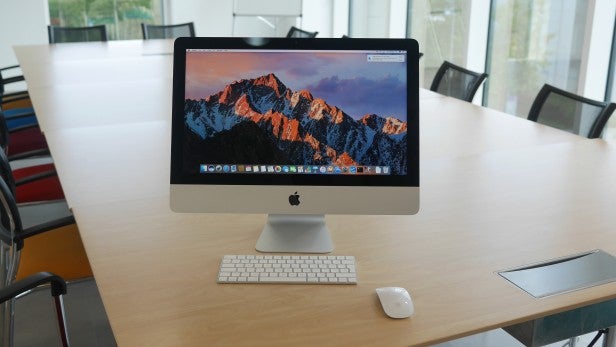
Should I buy the 21.5-inch iMac?
As far as Mac desktops go, the 21.5-inch iMac is a great piece of kit. It’s more expensive than advertised if you go opt for all the trimmings that I’d recommend – but, even then, up against the competition of all-in-one PCs we’ve reviewed in the past year, not much can touch it as an all-round package.
The machine that comes closest is the Lenovo Ideacentre AIO 910, which beats the iMac in a few areas including screen size, RAM, primary SSD and its ability to lie completely flat. But its processor and GPU are both slower, the peripherals aren’t great, and the screen isn’t as good in terms of colour coverage. And, of course, if you don’t like Windows it’s a non-starter.
Verdict
You need to spend a bit more on it to make it perfect – but even as it comes, the iMac is a compact desktop powerhouse.


